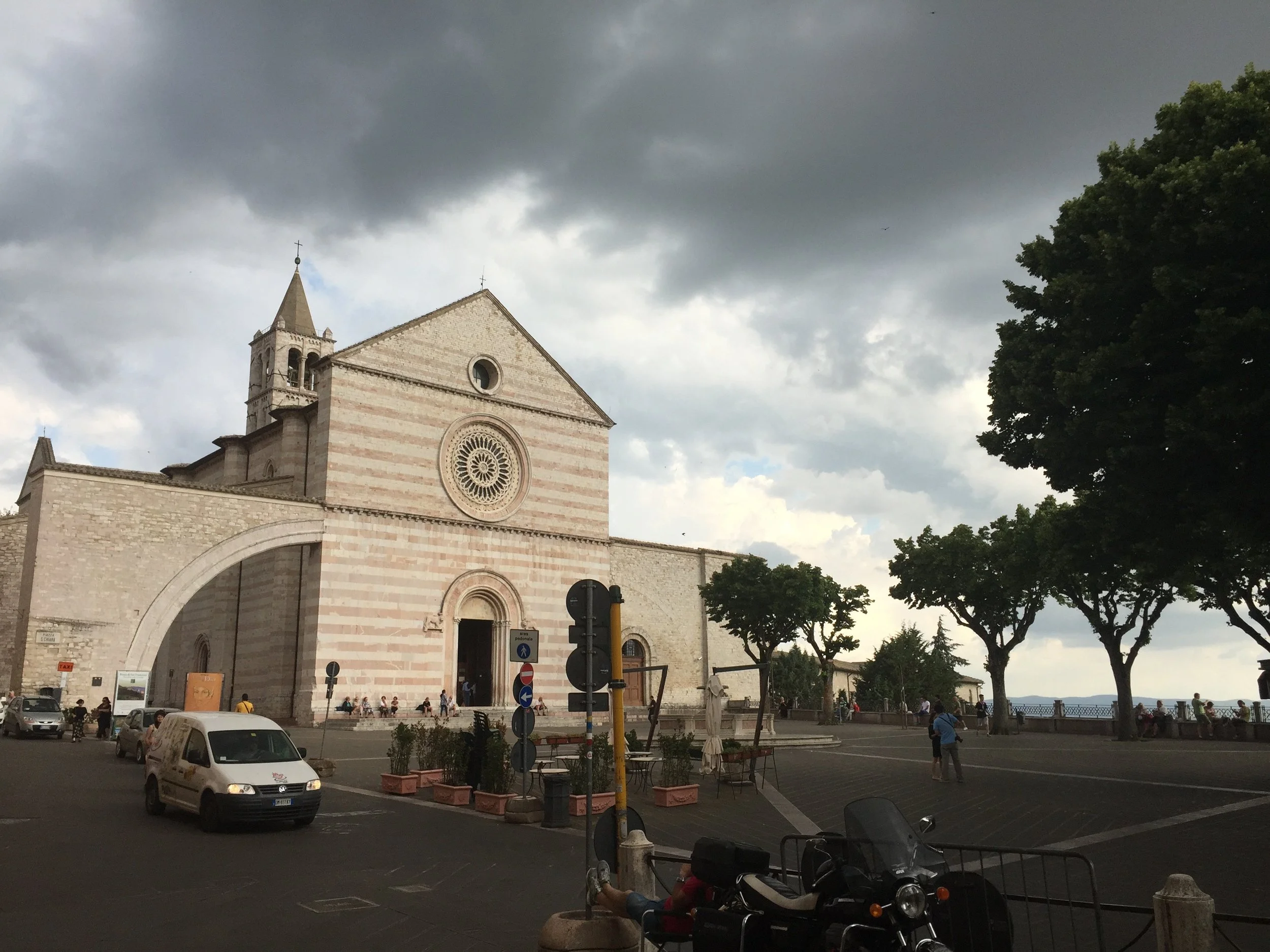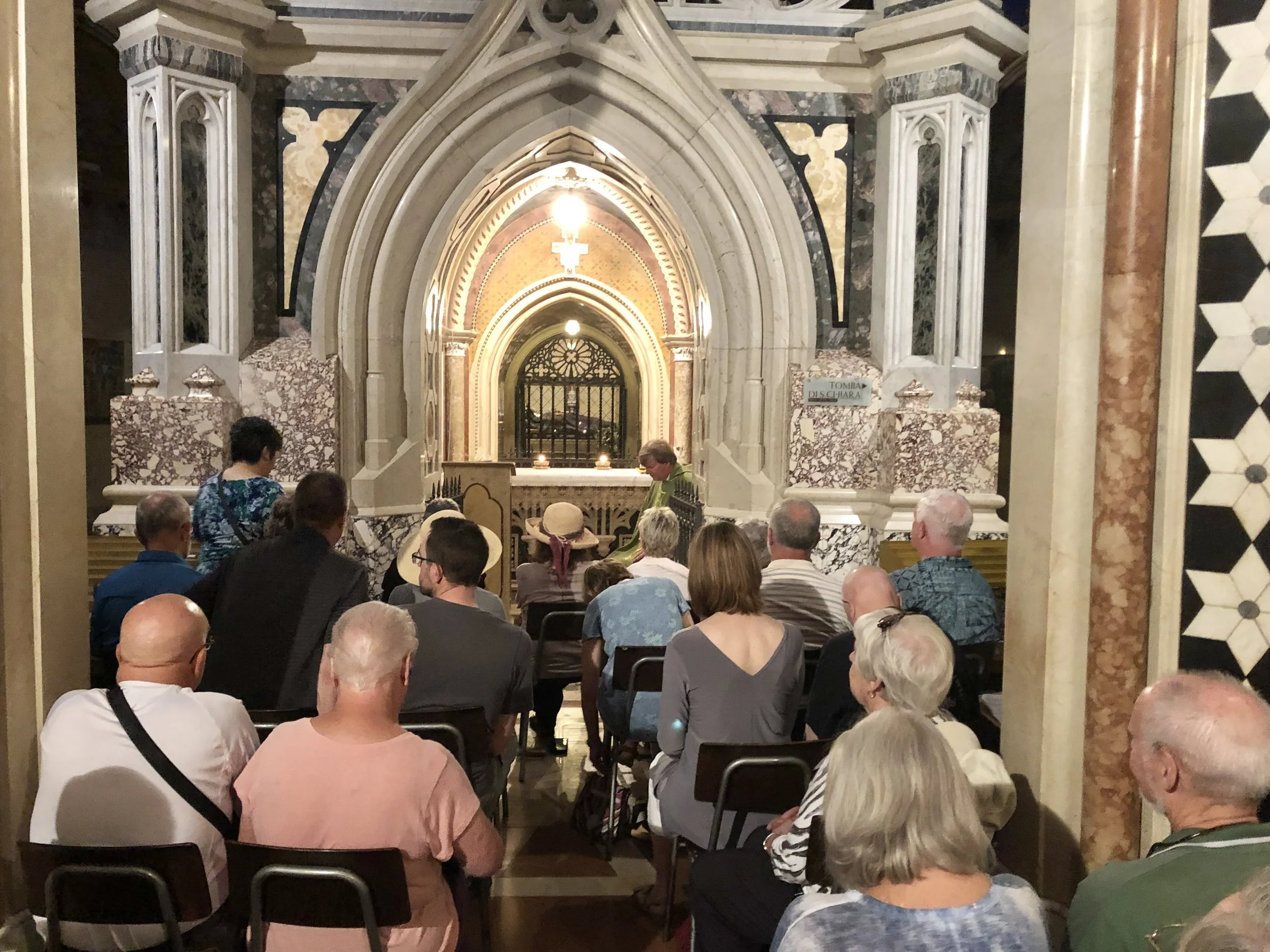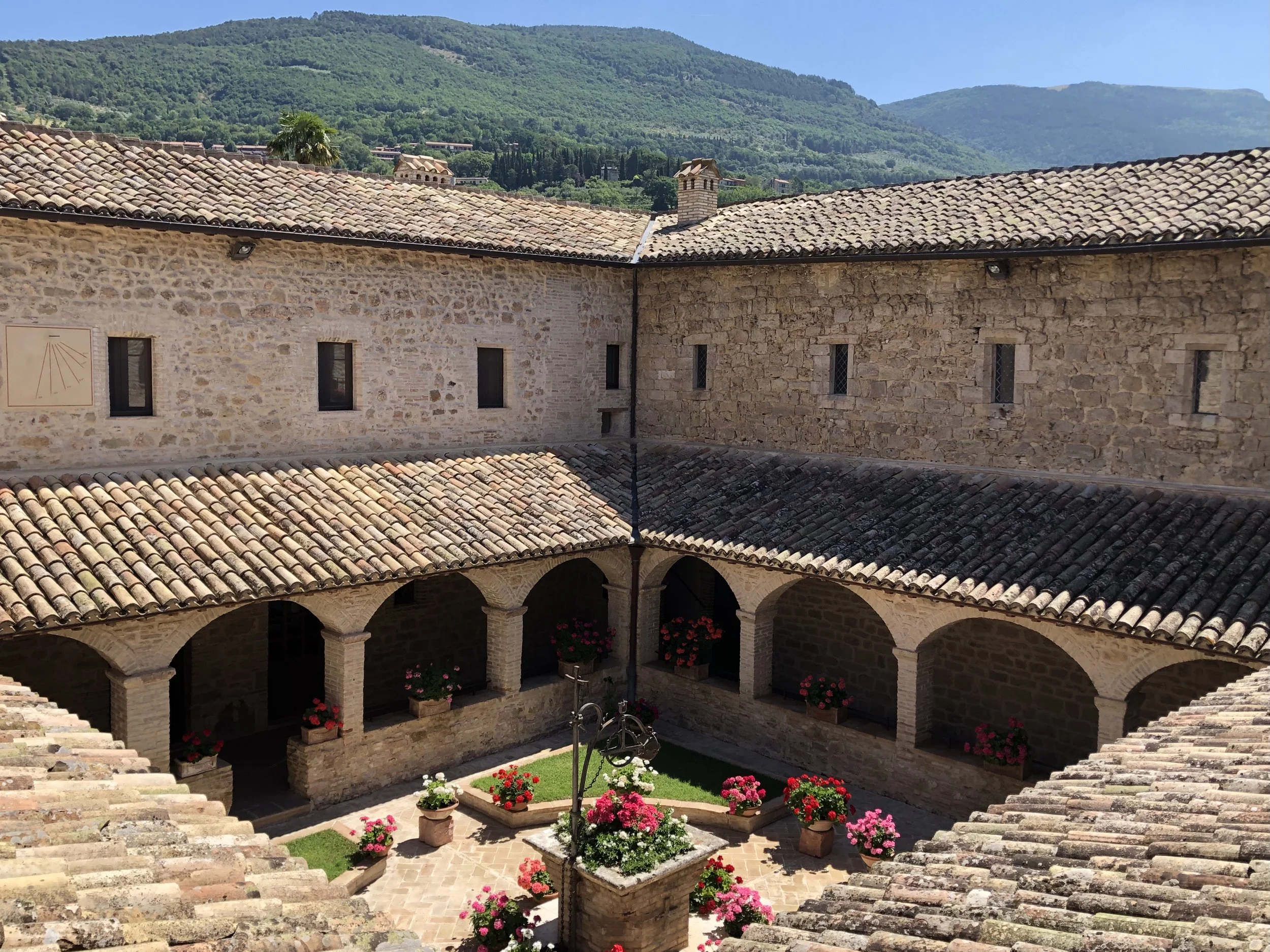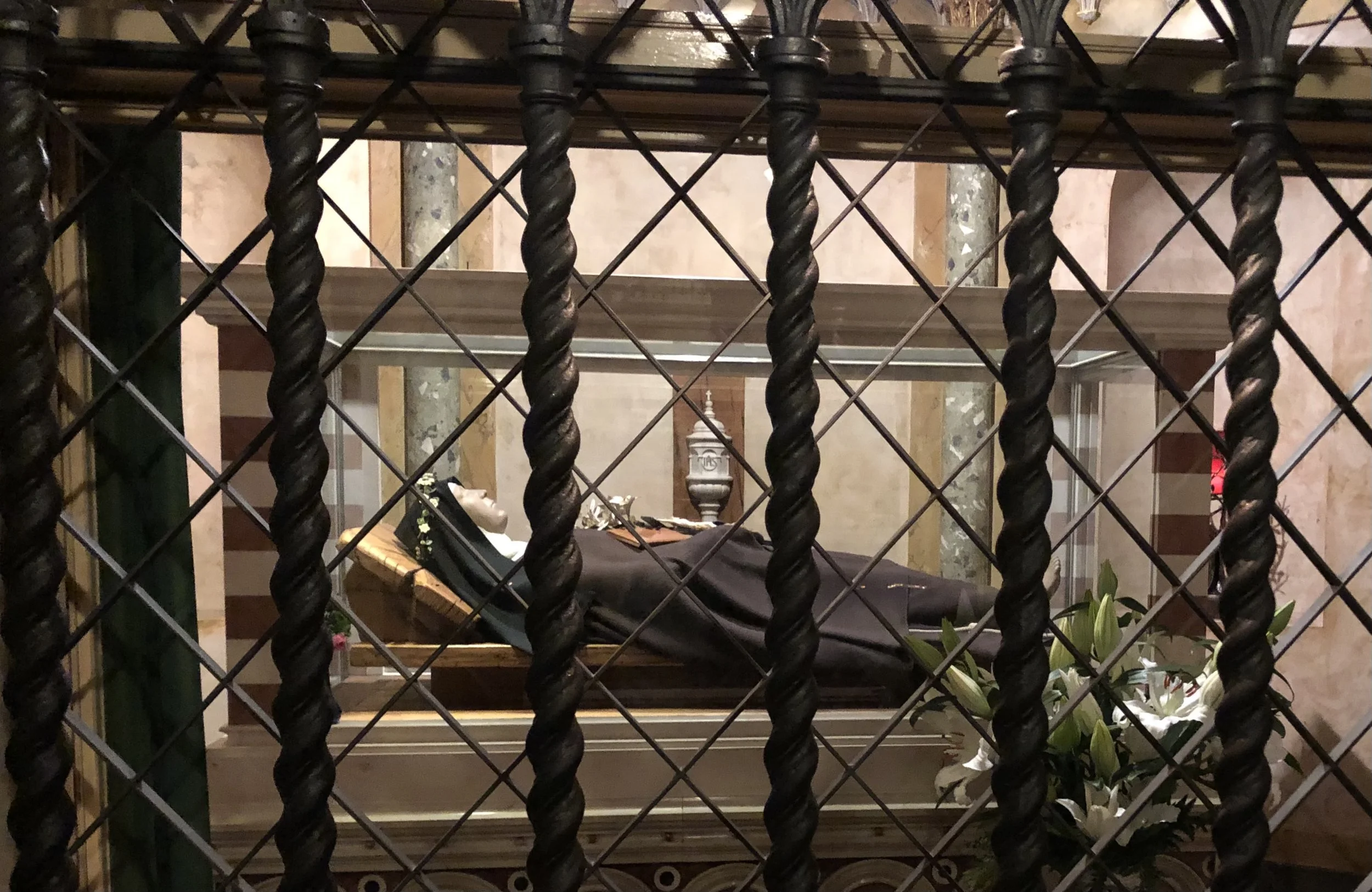Basilica of Saint Clare of Assisi
From: Sacred Destinations: Basilica di Santa Chiara:
“Clare died in Assisi on August 11, 1253. Like Francis, she was canonized quickly - on September 26, 1255, by Pope Alexander IV. The church of Santa Chiara was built in 1257-65, in the early Gothic style, to house her tomb.
Mass at Saint Clare’s tomb, celebrated by Fr. John Dear, during Pace e Bene Assisi Pilgrimage, 2019
“The Basilica of St. Clare is fronted by a terrace-like piazza with views over the valley and some shade trees. The church is early Gothic, but still has some Romanesque characteristics, such as round arches and an austere facade.
“The facade, made of horizontal bands of Assisian pink and white stone, is pierced by a wagon wheel rose window and a single round portal flanked by reliefs of lions. The building is stabilized on the north side by unattractive flying buttresses, added in 1351. Santa Chiara's campanile is the tallest in Assisi.
“The dimly lit nave has no side aisles and terminates in a small apse with fragmentary frescoes, three lancet windows, and a painted crucifix dating from before 1260 hangs above the choir. The graceful rib vault is supported by slender engaged columns on the side walls.
“The walls of the nave are now stark white, but were once covered in frescoes. Most were lost in the 17th century, but the transepts still contain 13th-century frescoes and two paintings, all by an unknown student of Giotto (who also painted at the Basilica of St. Francis) known as the "Expressionist Master of St. Clare."
“Adjoining the nave to the south is the Oratorio del Crocifisso (Oratory of the Crucifix), a peaceful chapel that preserves the venerated 12th-century crucifix that spoke to St. Francis at San Damiano. Also here are 14th-century frescoes by Puccio Capanna and Pace di Bartolo.
“Beneath the church is the spacious Neo-Gothic crypt containing the tomb of St. Clare. The saint's preserved body is on display at the east end of the crypt, her face protected by a layer of wax. A narrow ambulatory funnels pilgrims past the shrine.
“At the west end of the crypt, displayed behind a modern grille, are some important Franciscan relics, including humble tunics worn by Francis and Clare, a shirt Clare embroidered, and some locks of Clare's hair cut by St. Francis.”
Click here to see the exterior of Saint Clare’s Basilica in 360 degree panorama,
Introduction, Clare of Assisi: Early Documents
Raniero Cantalamessa, O.F.M. Cap.
“…While Clare follows the inspiration of Francis, she expresses it for an enclosed community and, thereby, implies a far more demanding way of life. To live without any stable form of income or support, without the freedom to go about begging for alms as the friars were doing: these expressions were unheard of in the lives of religious, and, undoubtedly, seen as utopian and naively presumptuous. Yet it is precisely her demanding way of poverty that so clearly underscores what is at its very heart: an unflinching confidence, even in the direst circumstances, in the loving providence of God. Clare's expression of poverty is far more dependent upon the generosity of others and is, therefore, thoroughly imbued with faith: faith in the goodness of people and faith in the overwhelming goodness of God….
“An unusual document concerning a piece of land, dated June 8, 1238, indicates that the monastery was filled with fifty sisters. By that date, according to some chroniclers, there were at least fifty new monasteries spread throughout Italy and large numbers in France, Germany, Bohemia, and Spain. It is difficult to determine the number with any precision, but the number of papal documents written to or about the Poor Ladies suggests their rapid growth drew considerable attention…
“Clare became the first woman to write a rule for religious women. During a period of forty years her ideals were becoming more clearly defined, especially as the [milder] Forms of Life of [their then-Protector, Cardinal Hugolino, later Pope Gregory IX] and Pope Innocent IV forced her to reflect upon the uniqueness of her own vision. At this point, the intimacy of her experience of Christ, flowing, as it did, from the teaching and example of Francis, made her more resolute.
“There has always been a temptation to interpret Clare's Form of Life in light of that of Francis from which it borrows. However, it is a unique document articulating that demanding expression of religious life that she perceived was her calling and, at the same time, a startling sense of individual freedom that was based on Clare's experience of the maturity of her sisters. Clare's insistence on its recognition and acceptance by the Church not simply as a privilege but as a right forged a new understanding of the role of charism in the unfolding of the Church's life….
“On September 16, 1252, Cardinal Rainaldo dei Conti di Segni, the Protector of the Poor Ladies, approved Clare's Form of Life in the name of the Pope. But this did not satisfy her. She continued to seek the personal approval of Innocent IV, the living sign of the Church's unity. This occurred on August 9, 1253 when the officials of the papal court realized that Clare was dying. On August 11, 1253, the Form of Life was brought to her carrying the seal of Innocent IV and, on the following day, Clare died. The crowning act of her life had just been completed: the ideals that she held so close to her heart had been accepted and ratified by the Church.”
Saint Clare saying goodbye to her sisters
The Legend of Saint Clare
Clare of Assisi: Early Documents, 314
“…in a little while the Roman Curia arrived in Perugia. The Lord of Ostia, after hearing about the increase of her sickness, hurried from Perugia to visit the spouse of Christ. [He had become] a father [to her] by his office, a provider by his care, always a dedicated friend by his very pure affection. He nourished the sick [woman] with the Sacrament of the Body of the Lord, and fed [those] remaining with the encouragement of his salutary word. Then she begged so great a father with her tears to take care of her soul and those of the other Ladies for the name of Christ. But, above all, she asked him to petition to have the Privilege of Poverty confirmed by the Lord Pope and the cardinals. Because he was a faithful helper of the Order, just as he promised by his word, so he fulfilled in deed…
“Lord Innocent IV of happy memory together with the cardinals hurried to visit the servant of Christ. … Entering the monastery, he went to her bed and extended his hand so that she might kiss it. …Then, with an angelic expression, she asked the forgiveness of all her sins of the Supreme Pontiff. He thereupon said: "Would that my need of pardon were such [as yours]!" He granted her the gift of perfect absolution and the grace of his fullest blessing…”







